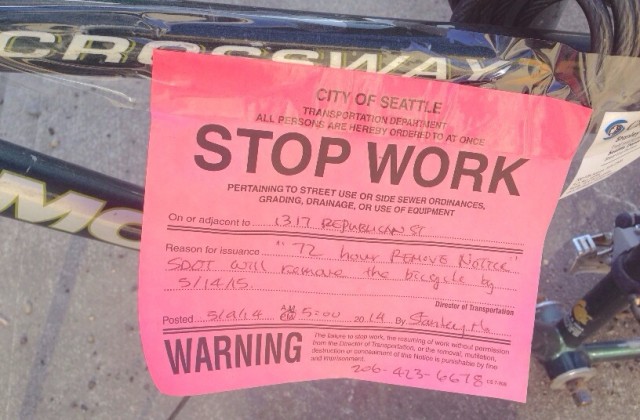ICYMI: Seattle For Growth Takes on Housing in Crosscut
Last week Crosscut gave me some real estate to talk about housing and why we’re not supportive of Mandatory Inclusionary Zoning (MIZ), especially the City of Seattle’s version of it, Mandatory Housing Affordability (MHA). Simply put, what MHA is squeezes money out of the development of market rate housing and funnels it into a very inefficient system of non-profit subsidized housing. You can read the whole post, “More housing, less bureaucracy: That’ll solve the housing crisis,” but here’s a couple key paragraphs.
Consider the economics of nonprofit housing development in Seattle — a well-intended model but one that recently produced just 88 units at a project called 12th Avenue Arts for a staggering $47 million, or about $500,000 per unit. That’s the purchase price of a townhouse in north Seattle or a condo in Capitol Hill (this figure is disputed by nonprofits and is currently under legislative review). But the project must house homeless people or people who are very poor, right? No. To make the project work, rents had to be set to the subsidy limit, 60 percent of area median income (AMI) — or about $1,100 per unit for a person earning $40,000. A person working full time making $15 an hour earns about $30,000 a year. So, a lot of people, especially among those who most need housing, are priced out from the start.
Why is this housing so expensive to build? For the same reason market-rate housing is: too many barriers, limits, rules and costs like design review and parking requirements that are self-imposed by the City Council. At a recent executive committee meeting of the board of directors of Capitol Hill Housing, a public development authority, a board member said of higher costs: “We could give examples of why it might be more expensive and that those things should be changed [i.e government regulations].”
Still, this is the Thin Slicer solution: Impose more limits on housing production to protect people who live here now. Then, as prices rise and more people struggle and qualify for subsidies, put a fee on the production of housing and give that to nonprofits (who labor under the same regulatory regime) to build some more subsidized housing. This pushes prices higher, creating a need for more subsidies.
While this makes for great political talking points, this cycle of exaction and subsidy is unsustainable and inflationary — making it more and more difficult for people with less money to live in cities.
Seattle Wants to Tax Jobs: More Money, More Money, More Money!
Seattle as a city and as a government is becoming notorious for creating task forces, committees, and other convening’s to come up with solutions to “big problems.” Almost without exception, the task force states the problem as “severe” a “crisis” or a problem at such as scale to demand action now. Usually there are big numbers to set the need, and then a decision that the problem simply needs more money. The recently convened task force to consider the reimplementation of a tax on jobs has followed the same pattern. This time, the task force wants $75,000,000 in taxes to help “resolve” homelessness and housing insecurity. But like every time before, there’s little concern about whether the solution, more cash, will actually solve the problem. Here’s the draft recommendations. It’s just assumed, more money solves problems — unless it’s prosperity.
There’s a long history with what has been called the Employee Hours Tax or the Head Tax. In 2009, the Seattle City Council acted to abolish this tax that was, at the time, rather modest. It generated about $5 million annually and was used mostly for improvements to bike and pedestrian infrastructure. Most business paid less than $100 for the tax and some bigger ones paid only in the thousands of dollars. At the time, I supported it because for a relatively small amount of money per business lots of money was available to make improvements to support people doing what we want them to do: walk, bike, or take the bus to work rather than drive.
Nevertheless, the Council acted on behalf of the business community and ended the tax. Now, the politics have turned and the Council has its eye on taxing jobs not for a few million dollars but $75 million and the task force said in it’s report, and even more on top of that in the for of debt, borrowed against the tax. The report shows the muddled thinking behind most Seattle efforts to solve “big problems.” Let’s take a look at the report.
First, one can detect in the document the words of someone trying to use reason. There is a voice somewhere on the panel pointing out that the
In considering the dedication of funding from an EHT, we recommend that the City give deep thought to the wide spectrum of needs and situations of people experiencing homelessness, recognizing that what works for one person may not work for another.
When talking about homelessness, the City likes to use the one night count then declare that the number indicates the number of units needed or likes to multiply that number by some factor to indicate how much money is needed. But that’s faulty. An accurate assessment of each and everyone of those people without any housing would indicate a “wide spectrum of needs” that might be helped with money but might be eased with process improvement. Figuring that out would, well, require work, something this City doesn’t like to do. Getting a big number and multiplying it by dollars is a lot easier.
But why even do that? The $75 millions doesn’t seem to be connected to anything about the costs.
Given the scale of the need for deeply affordable housing, shelter, and services, we recognize that an adequate response to the housing and homelessness crisis calls for hundreds of millions of dollars per year in new revenue in Seattle for at least the next ten years.
Why hundreds of millions? Who knows? The report doesn’t point back to any needs assessment. They might as well have said, “lots, and lots of money.” Just make up a number.
That voice of reason pops up again, though
The capacity of non-profit housing developers to take on new projects should be assessed and considered in making this decision. The difficulties of acquiring suitable land should also be taken into account.
Yes, that’s an interesting question. Once this fire hose of cash is trained on the problem, can the non-profits even lock up land and build all this housing they’d supposedly build? How much would it cost? Would it be in the $350,000 to $500,000 per unit range that it has been costing? This is a bit of an afterthought. And then there’s this comment in the report which would be hilarious if it wasn’t so outrageous,
Because of the cost of living in our region and the cost of new construction, we find that to resolve homelessness and the low-income housing crisis in Seattle would require new public funding on a grand scale –hundreds of millions of dollars per year for at least the next ten years.
See, we already have something grand, the Grand Bargain. Remember that? That’s going to tax new housing at about $14,000 per unit or more until 2025 and based on what the City is after will produce somewhere around $70,000,000 in money for housing each year. Zero consideration was ever given or even discussed on how that would impact prices of housing or whether it would realistically pay for it. I guess that bolsters the argument that we need “hundreds of millions” to build housing even though it’s unclear whether that is the solution that is most efficient, desirable or even achievable.
And speaking of where the money will come from, the thinking that supports all this is bizarre.
Despite the economic prosperity driving growth in the City’s revenues, and in part because of it, Seattle is facing a homelessness crisis of unprecedented proportions. (emphasis added, citation 2018 Proposed Budget Executive Summary, page 2).
That’s right, the reason why we’re in trouble here is because of jobs! All the prosperity is making things worse for poor people. So what do you do when something is bad for people and you want to discourage it? Tax it! That’s why there’s no other way to describe the recommendation other than a tax on jobs. If we had less prosperity and fewer jobs it’s for sure all those homeless people we see would just melt away back into the housing economy. Problem solved.
And here’s another gem from the report, this tax on jobs is
Inherently progressive in the specific sense that, because it is levied on employers rather than individuals or households, it is a way to raise revenue for public use without directly and disproportionately impacting lower-income residents in the way that, for example, sales taxes and property taxes tend to do.
Ahhhhh. Right. Lower income people won’t be impacted because the tax comes from employers (their emphasis), employers. Get it. Employers are’t people, and with all that money they’re making it won’t impact the way they do business at all. It certainly won’t discourage hiring new people and creating more jobs for poor people would it? I mean those new jobs are why people are poor in the first place? Well,
We note that there are no known data establishing that an EHT-like tax adversely impacts employment opportunities.
Got it. But then you can hear your elementary school teacher’s voice telling you why you should eat your vegetables.
And there is much data to show that business-friendly climates are jurisdictions that adequately address homelessness, fund quality schools, and maintain infrastructure necessary to move people and goods.
So don’t start walking around town suggesting that this new tax doesn’t make this an “unfriendly” place to do business because “much data” shows you are wrong!
And by the way, the assessment of this tax might be a little uneven. You know it’s going to be hard to tell and figure out exactly which business might be hurt by this and which ones will see the tax as a rounding error, because
The variables listed above that, as far as we understand, the City has the power to adjust are admittedly imperfect.
But the report goes on to say, let’s not let “the perfect be the enemy of the good.” Tax them all and let God sort them out!
Will non-profits pay? Maybe. How about the big non-profit housing industrial complex banging the drum for more money, more money and even more money?
It is reasonable and important to exempt many non-profits, especially those that provide housing, shelter, and services to low-income and homeless populations.
Well, sure, because those non-profits make housing, something that developers and builders and land lords don’t do; they make profits not housing, remember? When we tax market rate developers for new housing, that doesn’t add cost to housing making prices higher. Umm, the price of the land goes down! Yep, that’s it. The land owner takes it in the shorts. And will people who build and operate housing have to pay the jobs tax? Of course! They are just an employer, remember. And employers wouldn’t stop hiring employees and they certainly wouldn’t pass the cost of the tax on to consumers as higher prices for housing.
And all of this, a jobs tax, the housing tax that is part of Mandatory Inclusionary Zoning, rising property taxes, and increases in minimum wages, requirements for paid leave, and micromanaging of employee schedules is simply not enough. Of course not!
We also urge that the City work together with King County to prioritize lobbying the 2019 state legislature for more progressive revenue options, beginning mid-2018.
The depth of avarice and ignorance of how the economy works and lack of awareness of other extortion of businesses and property owners is staggering and seems studied. The bent of this group is, I guess, that all these costs will just get absorbed by the Tax Fairy; just put your latest tax under your pillow and tomorrow you’ll wake up and find all your problems are solved. It’s one thing to see prosperity and say tax it, but magical thinking to say, “prosperity causes poverty, therefore we should tax jobs so that there’s less prosperity.” Making more housing just makes the housing problem worse, so let’s tax that too. It’s only fair, right?
Winning Principles for Housing for the 2019 Legislative Session
As the legislative session winds down in Olympia, it isn’t too soon to start thinking about next year’s session. This year I think we did a pretty good job during the legislative session, defending the state’s preemption of local rent control measures, championing rural and urban collaboration with SB 6595, and forcing the non-profit industrial complex to explain the high costs of their product. Next year we’ll have to defend against rent control and a myriad of other measures to make it harder to make a living renting small and medium sized properties. But what are we for? What would a positive agenda for change in housing policy look like?
The best place to answer that question is start with some simple principles. What would are the underlying ideas be to support and measure policy proposals? At recent meeting talking about the next 18 months in housing policy at the state level there were three that emerged, more supply, fairness, and efficiency.
The Principles
- Housing supply– We need more housing in Washington State of all kinds, in all parts of the state, for people of all levels of income. More housing supply reduces price pressures for consumers, creates jobs, many other public benefits.
- Fairness– The people of Washington State expect housing resources, especially subsidies, to be distributed fairly between rural and urban, and for fair opportunities for both people who provide housing and those who live in it, whether they rent or own.
- Efficiency – We aren’t currently using our land and housing resources efficiently to provide housing for as many people as we could. Too much regulation is resulting in higher costs, less supply, and higher prices.
Another sensible question is what are the barriers to progress?
The Barriers
- Non-Profit Housing Providers– Many of the larger non-profit housing providers in the state are consuming most of the resources in the state for multifamily housing in urban centers. They are likely to resist changes to the status quo.
- The Growth Management Act (GMA) – The GMA and its advocates are not representing the interests of the environment or for smart growth, but instead contributing to limit to creating needed housing inside and outside the Urban Growth Area (UGA).
- One Party Rule – The alignment of urban Democrats, non-profits, and defenders of the current GMA form a stubborn and often inflexible barrier to needed reforms of housing policy at the state and local level
Not an easy set of opponents, are they? Sadly, the best intentions of the non-profit system have produced gross inefficiency. The Growth Management Act is now being abused to choke housing supply in and outside of the UGA, and urban Democrats and progressives only know one answer, more money, more money, more money for non-profits and supply limiting regulation.
Any legislative proposals for next session will have to increase supply, fairly promote housing all over the state, and support the efficient use of land and financial resources. But proposals will also have to be built on alliances that can overcome resistance from those who support the status quo; this likely means working with a strong urban and rural alliance that can connect back to the housing needs of immigrant workers in those communities.
The 2019 session may seem a long way away, and there is an election in between. So now’s the time to start getting more detailed ideas and legislation put together and building relationships with rural communities in the state that would benefit from better housing policy.
Mugatu Moment: MHA Fees Won’t Pay for Promised Non-Profit Subsidized Housing
In the press coverage of almost any public policy proposal there is a lot of debate about the numbers, especially how much new revenue might be raised and how it would be used. When it comes to Mandatory Inclusionary Zoning (MIZ) and Seattle’s version of it, Mandatory Housing Affordability (MHA) there seems to be very little curiosity about how the mandate to include affordable housing or pay a fee will turn out. How much money will be raised with the fee? How much subsidized housing will all that money pay for? These questions raise the stakes on figuring out how much non-profit subsidized housing really costs; if the fees generated by MHA are going to pay for units, shouldn’t we know how much those units would cost?
Armed with a calculator and plain reading of the online documents, I’ve come to the conclusion that, yet again, the MHA proposal simply doesn’t make sense on the spending side either; that is, in order to pay fees housing prices will go up but the fees generated don’t seem likely to cover the cost of very much housing.
Back in 2015, the MHA’s main assumption was announced by the Mayor: housing production for 10 years ahead would more or less match housing production for the previous 10 years. The idea was that MHA would be consistent with the Comprehensive Plan and previous real data. On page 2 of a document called Affordable Housing Production Model Summary, the City projects growth will occur “over the next 10 years, based on data from the last 10 years.”
That data in a report generated by the City’s Department of Construction and Inspection (formerly DPD), shows that about 47,000 units of housing were permitted between 2005 and 2015. Based on a conversation with a member of the Housing Affordability and Livability Agenda (HALA) Committee, the Mayor one day announced that the production of new housing would be 50,000 units over the next 10 years, 30,000 market rate and 20,000 affordable.
While these numbers align, it’s hard to find anything other than this guesswork in terms of what MHA assumes for production. It matters because if you’re going to charge a fee for something you ought to have of what it is supposed to pay for. In the first document I cited, and from what I remember, the number of subsidized units that would be created by MHA fees is pegged at 6,000 units. The number 50,000 appears in a later document, Implementing MHA Citywide (2017) again, with the Mayor’s numbers.
Let’s look at the numbers from the earliest documents I mention above. That model summary assumes that 50 percent of housing projects outside of Downtown and South Lake Union will include affordable units at somewhere around half of 6 percent inclusion of 30,000 units, or 900 units (30,000 * .06 =1,800/2 = 900). The rest of the units would be paid for with MHA fees. Let’s take a closer look at that.
The City’s model is that “new affordable housing funded by the Office of Housing (OH) is assumed to require a contribution of $80,000 per unit from OH (based on a model project leveraging four percent low-income housing tax credits and no additional public funds” (emphasis mine). Let’s take a look at an example, 12th Avenue Arts.
Let’s go with their board of directors argument that the project really didn’t cost $47 million dollars, but about half that, at least for the housing portion, or about $23 million or about $260,000 per unit. Using the City’s model, that project would have been eligible for about $7,000,000 in MHA funding. Based on a ULI case study, the project received $5,600,000 in 4 percent tax credit equity. If it received no additional public funds, the project would have about $12,600,000, or about $10,000,000 less than it needed to complete the project.
Keep in mind that the 50 percent participation is aspirational, so the likelihood that the number of units from performance will be less and, many of the projects in low-rise zones are for sale projects that won’t include subsidized units. While it is true that as performance rates fall, fees go up to offset the increased number of MHA funded units to hit the 6,000 goal, it doesn’t look like the $80,000 per unit figure is realistic given a dramatically discounted per unit costs I used.
None of this means that projects like 12th Avenue Arts won’t use other public sources of money, they would be allowed up to $1,500,000 in Housing Trust Funds (HTF), for example. Still, they’d be $8,500,000 short and that’s assuming a price tag weirdly and illogically discounted by 50 percent. The notion that $80,000 per unit is going to substantially offset the production costs of new non-profit subsidized housing strains credulity.
More importantly, if the fees suppress supply and eventually get added to the costs of new housing, those units will be less affordable and will add to the demand for non-profit subsidized units. If we believe the $427,000,000 figure for fees charged on roughly 30,000 units, that comes out to about $14,000 per unit — that’s about $1,400,000 for a hundred unit building, an astronomical increase in cost. Also keep in mind that the fees go as high as $35 per square foot, which means some projects, if we grant the City’s average estimate for size of housing, about 951 square feet, would be paying $3,300,000 for 100 unit building in a place like Capitol Hill.
The math gets even crazier if you consider the latest number is the most recent document of “20,000 affordable homes.” I did some math there and found that even backing out the 6,000 affordable units, and assuming the $80,000 allocation of MHA fees, the program would have to generate $1.2 billion in revenue, or about $33,000 per unit, to pay for those affordable units – and that’s assuming that those units can be produced with at least $2 in leverage from other funds ($160,000 per unit) and be completed at a cost of about $250,000 per unit.
I suppose someone else with time and a calculator could push these assumptions around, predict lower production costs, higher participation and market rate production, and get numbers that end up generating enough fees to cover the production costs of more non-profit subsidized housing. But my numbers are pretty conservative, that is, they are more or less based on the City’s model. Reality seems to be painting, and usually does, a different picture. Less participation means higher prices, and more demand for non-profit subsidized housing that gets more expensive as it seeks more and more sources of capital, even with MHA.
The bottom line here appears to be that the City’s projections are hopeful guess work and that there is no way to predict exactly how many market rate units will be produced over 6 years (an even shorter period of time than originally assumed) and how much demand there will be for fees to pay for non-profit subsidized housing. What’s most likely is that the massive fee hit many projects take won’t be enough, so non-profits will want even more. Yet when I read stories in the press they are all about the process and not the substance, NIMBYs and YIMBYs and no math, so I have yet another Mugatu moment: doesn’t anybody see this? I feel like I’m taking crazy pills!
High Costs Mean High Prices: Cost and Delay List Keeps Growing
The list of costs and delays to housing production in Seattle that I have been curating has grown to over 40 items. Each of these has it’s own stories. I am exploring how we can use Smartsheet to make the list accessible to builders and developers so they can add, elaborate, correct, and, I hope, add narratives to the list. Our people have many stories of the absurdity and frustration associated with housing and land use regulation in Seattle. These self-imposed problems and costs simply make prices higher and life harder for people with less money to spend on housing. I should add that while we’re not suggesting the abolition of sales tax and property tax, they need to be considered part of this list. Every increase, even for really good things, means higher housing prices. Maybe it’s worth it. Maybe all these things are worth higher housing prices, but that’s the debate we should have, not one about whether Amazon and growth is ruining the city.






